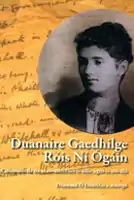Rose Maud Young | |
|---|---|
 Duanaire Gaedhilge Róis Ní Ógáin | |
| Born | 30 October 1866 |
| Died | 28 May 1947 (aged 80) Cushendun, County Antrim, Northern Ireland |
| Nationality | Irish |
| Other names | Rose Mabel Young; Róis Ní Ógáin |
| Occupation | writer |
Rose Maud Young (30 October 1866 – 28 May 1947) was an Irish writer, scholar and collector of Irish songs, best known for her work to preserve the Irish Language.[1]
Life and career
Young was born in Galgorm Castle, Ballymena, County Antrim, daughter and seventh of twelve children born to Grace Charlotte Savage, and John Young who was a prosperous unionist and high sheriff.[2] Despite his position he was a believer in tenant rights. Her younger sister was the writer Ella Young and her brother Willie Young was secretary of the Ulster Unionist League. Young was educated by governesses until 1884 before completing training as a teacher through Cambridge University. Young also attended Gaelic League classes in 1903 in London while visiting her sister who was living in the city at the time. After visiting the Bodleian Library she became committed to the study of the Irish Language.[3][4]
In the early 1900s Young returned to Ireland and continued her study of the Irish language in Belfast at Seán Ó Catháin's Irish College and in Donegal at Coláiste Uladh in Gort an Choirce. Young also stayed in Dublin and became friends with members of the Gaelic League and met Margaret Dobbs. Young worked with Dobbs on the Feis na nGleann (The Glens Festival), a gathering dedicated to the Irish language. Young was not involved in nationalism though she was strongly supportive of creating and maintaining a sense of "Irishness" through language and culture. She was also a friend and patron of Roger Casement. She also worked with Ellen O'Brien and contributed to O'Brien's book The Gaelic Church.[3] Young kept meticulous diaries.[5] Young became interested in Rathlin Island and the Gaelic spoken there.[4][6]
She was friends with and lived with Margaret Dobbs.[3][4] Rose Young is buried in the Presbyterian churchyard at Ahoghill, County Antrim.[7]
Bibliography
- Duanaire Gaedhilge (1921)
- Duanaire Gaedhilge a Do (1927)
- Duanaire Gaedhilge a Trí (1933)
References
- ↑ "Birth Record" (PDF). Retrieved 26 November 2016.
- ↑ "Person Page". Thepeerage. Retrieved 24 October 2016.
- 1 2 3 "Young, Rose Maud (1865–1947) -". Encyclopedia. Retrieved 24 October 2016.
- 1 2 3 Sean Mac Reamoinn (20 March 1996). "An Irishman's Diary". Irish Times. Retrieved 24 October 2016.
- ↑ "Vargas Llosa, Mario, 'Castle with a Ghost'". Irlandeses. Retrieved 24 October 2016.
- ↑ "The Dictionary of Ulster Biography". Retrieved 24 October 2016.
- ↑ Eamon Phoenix; Padraic O'Cleireachain (2005). Feis Na NGleann: A Century of Gaelic Culture in the Antrim Glens. Ulster Historical Foundation. pp. 37–. ISBN 978-1-903688-49-6.
Further reading
- Diarmid Ó Doibhlin, ed., Duanaire Róis Ní hÓgáin [with] Going Up the Glen, Protestant Womenfoldk of the Glens of Antrim and the Irish Language, an essay on Miss Young [launched by Lady Brookeborough, Tullyglass Hse. Hotel, Ballymena, 4 Dec. 1995]
- David Cooper (2009). The Musical Traditions of Northern Ireland and Its Diaspora: Community and Conflict. Ashgate Publishing, Ltd. ISBN 978-0-7546-6230-3.
- Eamon Phoenix; Padraic O'Cleireachain (2005). Feis Na NGleann: A Century of Gaelic Culture in the Antrim Glens. Ulster Historical Foundation. pp. 21–. ISBN 978-1-903688-49-6.
- Robert Anthony Welch (April 2014). The Cold of May Day Monday: An Approach to Irish Literary History. OUP Oxford. pp. 135–. ISBN 978-0-19-968684-1.
- Mario Vargas Llosa (5 June 2012). The Dream of the Celt. Faber & Faber. pp. 12–. ISBN 978-0-571-27573-1.
- O'Céirín, Kit and Cyril. Women of Ireland. TirEolas Irish Books.
- Margaret A. Zakem, freelance writer, Plymouth, Michigan